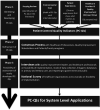Improving the quality of person-centred healthcare from the patient perspective: development of person-centred quality indicators
- PMID: 33122312
- PMCID: PMC7597468
- DOI: 10.1136/bmjopen-2020-037323
Improving the quality of person-centred healthcare from the patient perspective: development of person-centred quality indicators
Abstract
Importance: International efforts are being made towards a person-centred care (PCC) model, but there are currently no standardised mechanisms to measure and monitor PCC at a healthcare system level. The use of metrics to measure PCC can help to drive the changes needed to improve the quality of healthcare that is person centred.
Objective: To develop and validate person-centred care quality indicators (PC-QIs) measuring PCC at a healthcare system level through a synthesis of the evidence and a person-centred consensus approach to ensure the PC-QIs reflect what matters most to people in their care.
Methods: Existing indicators were first identified through a scoping review of the literature and an international environmental scan. Focus group discussions with diverse patients and caregivers and interviews with clinicians and experts in quality improvement allowed us to identify gaps in current measurement of PCC and inform the development of new PC-QIs. A set of identified and newly developed PC-QIs were subsequently refined by Delphi consensus process using a modified RAND/UCLA Appropriateness Method. The international consensus panel consisted of patients, family members, community representatives, clinicians, researchers and healthcare quality experts.
Results: From an initial 39 unique evidence-based PC-QIs identified and developed, the consensus process yielded 26 final PC-QIs. These included 7 related to structure, 16 related to process, 2 related to outcome and 1 overall global PC-QI.
Conclusions: The final 26 evidence-based and person-informed PC-QIs can be used to measure and evaluate quality incorporating patient perspectives, empowering jurisdictions to monitor healthcare system performance and evaluate policy and practice related to PCC.
Keywords: health policy; organisation of health services; quality in health care.
© Author(s) (or their employer(s)) 2020. Re-use permitted under CC BY-NC. No commercial re-use. See rights and permissions. Published by BMJ.
Conflict of interest statement
Competing interests: None declared.
Figures


References
-
- OECD Health Ministerial Statement - The next generation of health reforms, 2017. Available: http://www.oecd.org/health/ministerial/ministerial-statement-2017.pdf [Accessed Nov 2019].
-
- Institute of Medicine Crossing the quality chasm: a new health system for the 21st century. Washington DC: National Academies Press, 2001. - PubMed
-
- National Department of Health - National Health Service NHS 2010-2015: from good to great. preventative, People-Centred, productive, 2009.
Publication types
MeSH terms
Grants and funding
LinkOut - more resources
Full Text Sources
Medical
